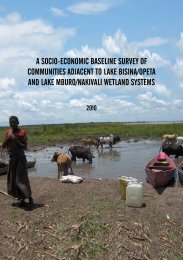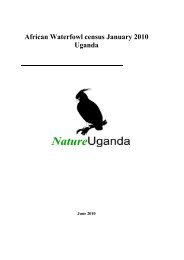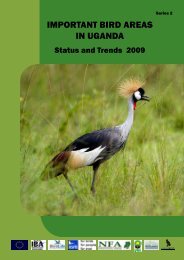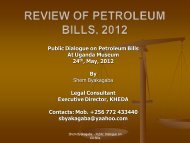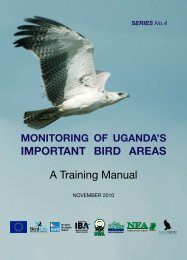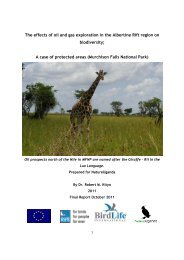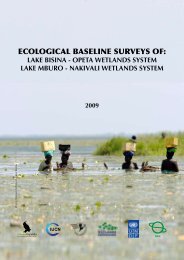the economic valuation of the proposed ... - Nature Uganda
the economic valuation of the proposed ... - Nature Uganda
the economic valuation of the proposed ... - Nature Uganda
You also want an ePaper? Increase the reach of your titles
YUMPU automatically turns print PDFs into web optimized ePapers that Google loves.
expected from <strong>the</strong> environment (Lette and de Boo<br />
2002). Despite <strong>the</strong> importance <strong>of</strong> <strong>the</strong> <strong>valuation</strong> <strong>of</strong> forests<br />
and nature, under-<strong>valuation</strong> was and still is <strong>the</strong> order <strong>of</strong><br />
<strong>the</strong> day, as a result <strong>of</strong> market and policy failures (Lette &<br />
de Boo 2002). Market failure has been identified as one<br />
<strong>of</strong> <strong>the</strong> major causes <strong>of</strong> under-<strong>valuation</strong> (Lette & de Boo<br />
2002). For example, when determining <strong>the</strong> <strong>economic</strong><br />
value <strong>of</strong> a forest, decision-makers usually only take into<br />
account <strong>the</strong> easily quantifiable – financial – costs and<br />
benefits related to goods and services traded on <strong>the</strong><br />
market, whereas <strong>the</strong>re are numerous functions <strong>of</strong> forests<br />
for which markets malfunction, are distorted or simply<br />
do not exist (Lette & de Boo 2002). Markets only exist<br />
for some <strong>of</strong> <strong>the</strong> production functions <strong>of</strong> forests, such as<br />
timber, fuelwood, and non-timber products. However,<br />
even if markets exist, market prices for <strong>the</strong>se goods may<br />
not reflect <strong>the</strong>ir real value, since markets can be distorted,<br />
for example by subsidies which represent policy failures<br />
(Lette & de Boo 2002). The authors suggest that <strong>the</strong><br />
market price <strong>of</strong> a particular good may not reflect all <strong>the</strong><br />
costs involved in producing that good because <strong>the</strong>re<br />
may be benefits or costs enjoyed or borne by o<strong>the</strong>rs not<br />
directly involved in <strong>the</strong> production <strong>of</strong> <strong>the</strong> good, what<br />
economists call externalities (Lette & de Boo 2002).<br />
In using <strong>the</strong> total <strong>economic</strong> value approach, <strong>the</strong> value is<br />
usually sub-divided into: (i) direct use values – benefits<br />
that accrue directly to <strong>the</strong> users <strong>of</strong> forests, whe<strong>the</strong>r<br />
extractive (e.g. timber and NTFPs) or non-extractive (e.g.<br />
ecotourism). Direct use values are most <strong>of</strong>ten enjoyed<br />
by people visiting or residing in <strong>the</strong> ecosystem itself; (ii)<br />
indirect use values – benefits that accrue indirectly to<br />
users <strong>of</strong> forests, primarily ecological or environmental<br />
32<br />
services; (iii) option value – <strong>the</strong> amount that individuals<br />
would be willing to pay to conserve a forest for future<br />
use (e.g. biodiversity values) <strong>of</strong> resources <strong>the</strong>y may<br />
not be using at present; (iv) bequest value – <strong>the</strong> value<br />
attached to <strong>the</strong> knowledge that o<strong>the</strong>rs might benefit<br />
from a forest area in <strong>the</strong> future; and (v) existence value<br />
– <strong>the</strong> value placed by non-users on <strong>the</strong> knowledge that<br />
something exists, i.e. its intrinsic value.<br />
5.2.2. The Total Economic Value<br />
Various <strong>valuation</strong> tools have been developed to<br />
estimate <strong>the</strong> monetary value <strong>of</strong> non-marketed goods<br />
and services (Lette & de Boo 2002). Munasinghe’s<br />
classification <strong>of</strong> major value categories has proved to<br />
be a useful analytical tool to link value categories and<br />
<strong>the</strong>ir underlying environmental goods and services<br />
with specific <strong>valuation</strong> tools (Munasinghe 1992; Lette<br />
& de Boo 2002) as shown in Table 15. While <strong>the</strong> direct<br />
use value <strong>of</strong> goods and services traded on <strong>the</strong> market<br />
can be easily translated into monetary terms by taking<br />
<strong>the</strong>ir market prices, <strong>the</strong>re are a lot <strong>of</strong> o<strong>the</strong>r goods and<br />
services <strong>of</strong>ten conceived as having direct use values.<br />
These functions can be better valued by means <strong>of</strong><br />
o<strong>the</strong>r <strong>valuation</strong> tools (e.g. Related Goods Approach,<br />
Hedonic Pricing or Travel Cost Method). The regulation<br />
functions <strong>of</strong> forests from which indirect use value is<br />
perceived can also be valued by various <strong>valuation</strong><br />
tools (e.g. Replacement Cost Technique, Production<br />
Function Approach). To capture option, bequest and<br />
existence values, Contingent Valuation Method (CVM) is<br />
used to estimate <strong>the</strong> monetary value <strong>of</strong> environmental<br />
amenities ( Lette & de Boo, 2002).<br />
The Economic Valuation <strong>of</strong> <strong>the</strong> Proposed Degazettement <strong>of</strong> Mabira CFR | 2011



